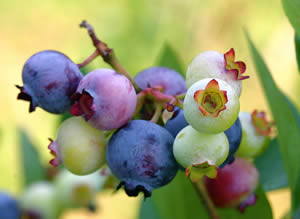Blueberry Vaccinium spp
- Common Names
- Blueberries , blueberry, huckleberry, ligonberry
- Botanical Name
- Vaccinium spp
- Syn. Vaccinium corymbosum
- Family
- ERICACEAE
Medicinal Uses & Benefits of Blueberries
![]() How to Use|
Side Effects |
Plant & Garden|
How to Use|
Side Effects |
Plant & Garden|
- Medicinal Uses: * Gout
* Longevity Tonics
* Memory/Focus
* Nutrition
- Properties: * Antioxidant
- Parts Used: Fruit, leaf
How to Use: Blueberry
Blueberries are a naturally delicious treat that can be enjoyed without hesitation - a totally guilt free pleasure. There are many different species of North American blueberries adapted to thrive in climates from Alaska (Vaccinium alaskaense) to the Carolina farkleberry (Vaccinium arboreum). Blueberries are of special interest in the functional/medicinal food category due to the high levels of anthocyanin and polyphenolic antioxidant compounds they contain. Blueberries have a higher antioxidant capacity (in some cases as high as 40-50 mmoles TE/g) than other healthy fruits and vegetables; by comparison, kale, strawberries and spinach have relatively high antioxidant capacities of 17.7, 15.4 and 12.6 mmol TE/g.
Blueberries are very similar in composition to the cranberry and the European species bilberry. While bilberries, Vaccinium myrtillus, have a stronger history of use in folk medicine, and have been the subject of much more scientific study, there is no strong reason to suggest the Vaccinium spp. of North America are slackers in comparative health benefits. People might well turn to their own backyard species of blueberry as more information comes to light. Fruits harvested at the peak of ripeness have the highest amount of antioxidants compounds, no matter whether your local cultivar is Rabbiteye, Lowbush, Highbush, or Bilberry. 1
Recent research suggests that fresh or frozen whole blueberry fruits blended in smoothies may be more important in maintaining health and athletic performance than consuming generic dietary supplements, so blend away!2 In one small study blueberry juice appeared to improve memory function in older adults with early memory impairment. This may suggest that blueberries may be useful in delaying the memory impairment and cognitive decline associated with aging. 3
Preparation Methods & Dosage :Eat fresh or frozen fruit in desserts, smoothies and as a healthy snack.
Blueberry Remedies
Blueberry Side Effects: None Noted
Plant Description
- Plant Class:Perennial Shrubs: Smaller or wild species are "lowbush blueberries" and the larger species are known as "highbush blueberries".
- Flowers/Fruit/Seeds: flowers are bell-shaped, white, pale pink or red, sometimes tinged greenish, fruits ripen from green to a dark blue, indigo when ready to eat.
- Parts used: Fruits, leaves
- Leaves:Leaves can vary between deciduous or evergreen, ovate to lanceolate depending upon type.
- Flowering Season:Variable
- Distribution: Native to North America. Many different species spread throughout all latitudes of the north american continent.
Related Species Vaccinium vitis-idaea L. lingonberry, northern mountain cranberry; Vaccinium angustifolium lowbush blueberry
- . Blueberry Smoothie Aids Recovery of Exercise-induced Muscle Damage , American Botanical Council, (): ,
- Krikorian R, Shidler MD, Nash TA, et al. . Blueberry supplementation improves memory in older adults. , J Agric Food Chem. 2010;58(7):3996-4000, (2010): American Botanical Council,

- Bradham RR, Gangemi JD. . The Medicinal Potential of Blueberries , The Journal of the South Carolina Medical Association. Vol 96, (July 2000:300-303): American Botanical Council,














